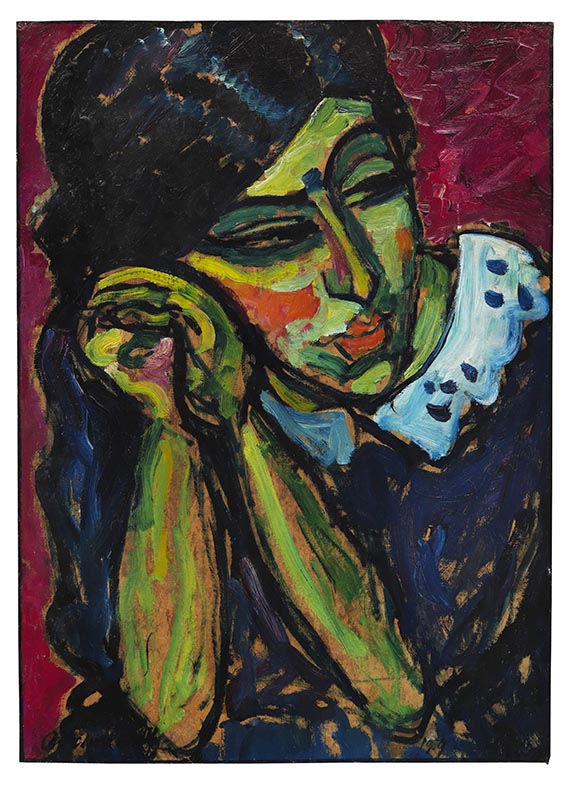Dictionary


Expressionism
Expressionism is regarded as one of the most multifaceted and most influential movements in art in the 20th century. Accordingly, any attempt to come up with a universal definition of Expressionism is a difficult task, as the description itself is already intricate. But yet, among those artists attributed to Expressionism, some common features can be observed.
The expressionists regarded themselves as an antipole to 19th century materialist Realism and Impressionism. In line with the topos of inner perception, they asked for a more spiritual approach to the world, which would transcend outer appearances and find expression in their pictures. The compositional means complied with this ambition, preferring simplified, at times not identifiable forms and freely used strong colors. The expressionists followed artists that put a strong emphasis on psychic expression and created compositions with strong symbolic meanings. Among those worthwhile mentioning are Edvard Munch, Vincent van Gogh, Paul Gauguin and the group "Nabis"
Expressionism mainly developed in Germany, where the movement's two most important groups formed, the "Die Brücke" (The Bridge) was founded in Dresden in 1905 and the Munich group "Der Blaue Reiter" (The Blue Rider) in 1911. All these artists had a similar mindset in common. They were inspired by the so-called "primitives" - a term that does not only refer to art from outside of Europe, but that comprises works by children as well as of mentally ill people - and had a deep interest in mysticism and occultism. The myth of nativeness also played a decisive role and coined the expressionist's view of nature and the big city. Additionally, an emphasis on the spiritual of the "Blaue Reiter" led to an increasingly abstract art, whereas the "Brücke" artists represented a concept of the figurative that was strongly influenced by African art.
Even though Expressionism did not outlast World War I, the expressionist view of the world had a sustainable effect on the art of the 1920s and 30s. Without it, it would not have been for Bauhaus and New Objectivity. The most important expressionists were Erich Heckel, Ernst-Ludwig Kirchner, Karl Schmidt-Rottluff, Hermann Max Pechstein, Emil Nolde, Otto Mueller, Wassily Kandinsky, Franz Marc, Gabriele Münter, Paul Klee, Alfred Kubin, August Macke, Alexej von Jawlensky and Lyonel Feininger.
Expressionism is regarded as one of the most multifaceted and most influential movements in art in the 20th century. Accordingly, any attempt to come up with a universal definition of Expressionism is a difficult task, as the description itself is already intricate. But yet, among those artists attributed to Expressionism, some common features can be observed.
The expressionists regarded themselves as an antipole to 19th century materialist Realism and Impressionism. In line with the topos of inner perception, they asked for a more spiritual approach to the world, which would transcend outer appearances and find expression in their pictures. The compositional means complied with this ambition, preferring simplified, at times not identifiable forms and freely used strong colors. The expressionists followed artists that put a strong emphasis on psychic expression and created compositions with strong symbolic meanings. Among those worthwhile mentioning are Edvard Munch, Vincent van Gogh, Paul Gauguin and the group "Nabis"
Expressionism mainly developed in Germany, where the movement's two most important groups formed, the "Die Brücke" (The Bridge) was founded in Dresden in 1905 and the Munich group "Der Blaue Reiter" (The Blue Rider) in 1911. All these artists had a similar mindset in common. They were inspired by the so-called "primitives" - a term that does not only refer to art from outside of Europe, but that comprises works by children as well as of mentally ill people - and had a deep interest in mysticism and occultism. The myth of nativeness also played a decisive role and coined the expressionist's view of nature and the big city. Additionally, an emphasis on the spiritual of the "Blaue Reiter" led to an increasingly abstract art, whereas the "Brücke" artists represented a concept of the figurative that was strongly influenced by African art.
Even though Expressionism did not outlast World War I, the expressionist view of the world had a sustainable effect on the art of the 1920s and 30s. Without it, it would not have been for Bauhaus and New Objectivity. The most important expressionists were Erich Heckel, Ernst-Ludwig Kirchner, Karl Schmidt-Rottluff, Hermann Max Pechstein, Emil Nolde, Otto Mueller, Wassily Kandinsky, Franz Marc, Gabriele Münter, Paul Klee, Alfred Kubin, August Macke, Alexej von Jawlensky and Lyonel Feininger.
Offers for Expressionism




